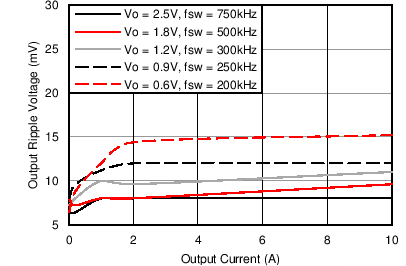JAJSBZ7E JULY 2013 – December 2019 LMZ31710
PRODUCTION DATA.
- 1 特長
- 2 アプリケーション
- 3 概要
- 4 改訂履歴
- 5 Pin Configuration and Functions
- 6 Specifications
-
7 Detailed Description
- 7.1 Overview
- 7.2 Functional Block Diagram
- 7.3
Feature Description
- 7.3.1 VIN and PVIN Input Voltage
- 7.3.2 3.3-V PVIN Operation
- 7.3.3 Adjusting the Output Voltage (0.6 V to 5.5 V)
- 7.3.4 Capacitor Recommendations For the LMZ31710 Power Supply
- 7.3.5 Transient Response
- 7.3.6 Power Good (PWRGD)
- 7.3.7 Light Load Efficiency (LLE)
- 7.3.8 SYNC_OUT
- 7.3.9 Parallel Operation
- 7.3.10 Power-Up Characteristics
- 7.3.11 Pre-Biased Start-Up
- 7.3.12 Remote Sense
- 7.3.13 Thermal Shutdown
- 7.3.14 Output On/Off Inhibit (INH)
- 7.3.15 Slow Start (SS/TR)
- 7.3.16 Overcurrent Protection
- 7.3.17 Synchronization (CLK)
- 7.3.18 Sequencing (SS/TR)
- 7.4 Device Functional Modes
- 8 Application and Implementation
- 9 Power Supply Recommendations
- 10Layout
- 11デバイスおよびドキュメントのサポート
- 12メカニカル、パッケージ、および注文情報
6.8 Typical Characteristics (PVIN = 3.3 V, VIN = 5 V)
The electrical characteristic data has been developed from actual products tested at 25°C. This data is considered typical for the converter. Applies to Figure 12, Figure 13, and Figure 14. The temperature derating curves represent the conditions at which internal components are at or below the manufacturer's maximum operating temperatures. Derating limits apply to devices soldered directly to a 100-mm × 100-mm double-sided PCB with 2 oz. copper. Applies to Figure 16. Figure 12. Efficiency versus Output Current
Figure 12. Efficiency versus Output Current  Figure 14. Power Dissipation versus Output Current
Figure 14. Power Dissipation versus Output Current  Figure 16. Safe Operating Area
Figure 16. Safe Operating Area  Figure 13. Voltage Ripple versus Output Current
Figure 13. Voltage Ripple versus Output Current  Figure 15. VOUT= 1.8 V, IOUT= 10 A, COUT1= 200 Μf Ceramic, FSW= 500 Khz
Figure 15. VOUT= 1.8 V, IOUT= 10 A, COUT1= 200 Μf Ceramic, FSW= 500 Khz